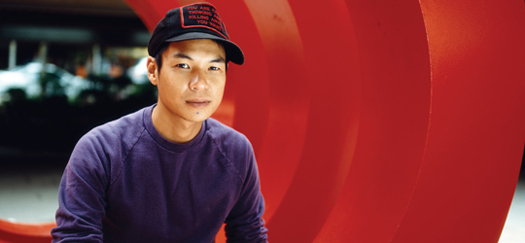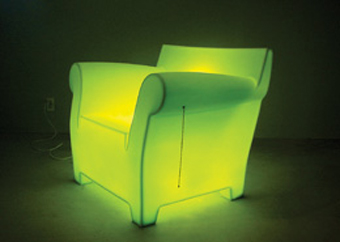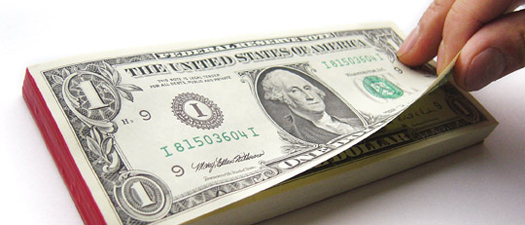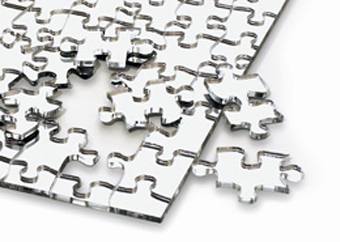
Images courtesy of Tobias Wong
As for the rest of what makes him interesting, well, where to begin? Since his 2001 public debut — which involved the neo-Duchampian conversion of a Philippe Starck chair into a lamp — he’s attracted attention with a range of provocative projects like his Killer Ring, with the stone set so that the sharp end points outward; the Money Pad, a stack of 100-dollar bills bound with notepad glue; and the 9/12 Airport Giftshop, for the Terminal 5 exhibition at JFK Airport (which later became infamous when it was shut down immediately after a reportedly raucous opening party). He cut Karim Rashid’s book I Want To Change The World into a gun shape; borrowed (okay, took) Burberry’s famous plaid pattern to make buttons; and in a collaboration with Ken Courtney (of fashion line Ju$t Another Rich Kid), made gold-plated versions of a coffee stirrer that McDonald’s had discontinued because people were apparently using it as a coke spoon. One of his most recent projects was The Wrong Store, in New York’s Chelsea neighborhood. Wong and Gregory Krum (The Cooper-Hewitt National Design Museum’s Director of Retail) lined up an amazing array of product-artists for a collection that addressed the shop as gallery and the gallery as shop. Art fans and potential shoppers who turned up for the opening eventually figured out that, to top it off, the store was never going to open.

Wong himself is as mercurial as his projects: while he admits to giving in to consumer hype and waiting in line for an iPhone, tattooed on his arm is the Jenny Holzer truism: “Protect me from what I want.”
Theme: The design world can be a bit confusing; I’ve seen you described an “industrial designer,” and an “artist/designer,” among other things. Which context do you think of yourself in?
I no longer worry about what title people give me, I’m happy being whatever fits the context. I don’t draft or create models/prototypes, I don’t problem solve, and I definitely don’t make things to make life easier.
So what was it that first drew you to design, as a vocation?
I never really studied design formally (with the exception of a few years of architecture, but that doesn’t count). I studied sculpture at Cooper Union, a school with an amazing program that allowed me to explore any medium I wanted to. During my senior year, I gravitated towards using design as a medium because I felt there was a void in the process of creating design work, specifically during the conception stage. I wanted to apply my interests in conceptual art towards design and see what would happen.
My debut design project was This is a Lamp (2001), converting a Philippe Starck chair for Kartell into a lamp, and claiming it as a brand new object and design (and exhibiting one night before the debut of the actual Starck chair). I applied Dadaism ideas to that project, and it worked, much the same way a urinal became a fountain.
So I’m here to challenge the design world, the same way Duchamp did the art world. But I do find the design world extremely confusing as well, although no more confusing than the art world.

Did you ever consider going the traditional design route, interning at a design firm and so on?
Luckily This is a Lamp got my name out there, [so I was] able to start making my own work, rather than working on others’ work. I was never interested in interning at a design firm. It wasn’t an ego thing — an internship is a nonpaying thing, and I really needed to work for money. At Cooper Union they taught us if you wanted something fabricated, something made, you just go online or on the phone and you can get it done. Especially in New York.
I guess New York is a place where you can get a lot of things done.
I don’t work so well elsewhere; there’s just so much energy in New York.
Which neighborhood do you live in?
The East Village, which I love, it’s my favorite part of the city. It’s much quieter now, a lot of the scenesters have moved out. I’m more of a geek than a hipster. I just feel very comfortable there. I’m a real homebody when I’m in New York.
You seem to have a keen interest in how people spend and think about money, and the acquisition of physical objects.
When I moved from Canada to New York, I was fascinated by how obsessed Americans were with material goods. It was crazy how luxury and any sort of goods were so disposable. I wanted to explore and expose the madness behind it all. So I shopped to find out, excusing it as research for my art projects. But ten years later and after much criticism of American consumer culture, I found myself camped out in line as the 15th person to get an iPhone!
Why? Was it about the object, or the cultural phenomenon? I felt like that whole thing was sort of the Beatlemania of consumerism.
I’m a gadget freak, I’ve gone through a million palm pilots, but I had no intention of buying an iPhone. I was skeptical when I read they were going to have no buttons — Palm and other PDA makers tried doing that, and had to bring the buttons back. But the hype and the commercials blasting on the television just magically drove me to get in line — and it felt great. There’s something about giving in to your desires, that feeling of “I don’t know why I want it, but I do” that’s very satisfying. Also the high of making certain that I was one of the first to get one was amazing.

Let’s skip ahead to the very recent past. What was the guiding idea behind the Wrong Store, and did that project turn out as you expected?
The Wrong Store project was conceived as a means to address consumer culture and desires directly, without the pressure of commerce. Nothing was for sale, at least not individually, and there was no underlying pressure to buy or sell anything. That allowed us to really explore the creative side of marketing, buying, and the retail/gallery/art world.

It’s one thing to think up an idea like that, but once you had the basic idea, what order did you do things in? Find a space or approach artist/designer/contributors with the idea first? Or financing?
The space came first, about a year ago. I was invited by Zach Feuer [of the Zach Feuer Gallery in Chelsea and the Kantor/Feuer Gallery in Los Angeles] to do something in this tiny little space he co-owned. After the initial visit, the idea to play off the Wrong Gallery [a nearby “gallery” that was really little more than a fancy-looking door with permanent “closed” sign] was almost immediate. It took about six months to prepare, a week to install, and a few more to wrap up.

And how did you finance it?
That question hits an important point in my work (and pet peeve), because many people are always interested in how I get work out there, financially. And it’s quite simple. If there’s something I really believe in, I just find a way to make it happen. No daily Starbucks (US$4) or cigs ($8) or dining out ($20), and before you know it you’ve got the money to do something.
We self-financed the entire Wrong Store project, and it wasn’t cheap. But while we actually couldn’t afford it, we really couldn’t afford to pass on the opportunity. We didn’t want to rely on any sponsors, because we didn’t want to answer to anyone, or let them get in the way. So we saved and put our own money away for months. We thought the creative outcome was worth the investment.
I get really frustrated with young artists or designers who yap about all the great ideas they have and don’t take any action because they’re waiting for a manufacturer, sponsor, or whatever to help. Or even worse, they’re waiting to “make it big” to realize these projects.
In another interview you said: “I’d be lying if I said, ‘Just do what your heart tells you, stay true to yourself, and things will eventually come’ — that’s bullshit. It’s all about strategies and risks.” I frequently interview independent creators, and when asked advice on achieving success, a lot of them say “Just be true to yourself.” Sometimes I even say, “Please don’t give me any bullshit about ‘being true to yourself,’ that’s not helpful advice, we’ve all heard that one before,” and they say it anyway. Do you think this is just an image thing, that people want you to believe their work is so good that of course it got recognized? Like they don’t want to admit that they self-promote, or compromise, or strategize?
That’s really funny. I think it’s true, it being about image, kinda like they’re saying, “What took you so long?” And so much easier said when you do stumble across (some) success. But what about the other 99.9 percent? Why encourage a road with a dead end? I don’t want to sound rude, but I’m also not a hopeless romantic.

Unfortunately, these days we’re all driven by this commercial measure of success and both designers and artists are determined to create so they can be at a Sotheby’s auction one day. But hey, don’t get me wrong, I’ll take any kinda money that comes my way. I’ve got other projects I need to fund!
And I still stand by [what I said in the quote], because anything else truly is bullshit. I’m a strong believer in, “Quit while you’re ahead and move on to something else quickly.”
I really liked the Money Pad. What’s the story on that piece?
I was just playing with luxury at the time. Being able to hold a wad of cash is something that’s amazing; that was a fun project. I had it bound with peel-able notepad glue, and backed it with cardboard, and I would carry it in my back pocket, just peel as you go.
What did the printer say about it?
Well, Kinko’s wouldn’t do it.
You took it to Kinko’s?
Yeah, they offer binding services, but they said they couldn’t play with money; it was a federal offense. So I eventually found a little East Village printer who would do it. With my work at the time, I was having to consume other people’s work, and then sell it. So I was toying with: How do you mark the price of something up? I had to buy the Kartell chair retail, and then I would have to double that. So what happens when I take money and make that art? What is a hundred dollars — no more, no less — worth as an art piece?

So what was it worth?
It was worth three hundred dollars. I decided the buyer would pay three hundred, I would get a hundred, the gallery or retailer would get a hundred, and the buyer would get a hundred. So we’d be even.
What kinds of reactions have you gotten from some of the big brands that your work has dealt with, sometimes through borrowing without permission, like the Burberry buttons and the McDonald’s “coke spoon?”
Burberry loved it. That project came about because in a magazine I saw they had this full-page warning saying “This tartan is ours, and anyone using it will be prosecuted.” And I was like, “Oh, I’ve got a project.” So I was handing out these Burberry tartan buttons at openings, you know, small/medium/large, the same way they’d do clothing.

I actually called them up. I was worried about making the call, they’re such a big company, they could crush me. And it was an illegal thing. But I wanted to get a few of their buttons, and they weren’t selling them. They said, “Oh, we’re so glad you called, we had seen these buttons and heard someone from Pratt was making them.” I said, “Hell no, Cooper Union!”
As for McDonald’s, they asked us very politely if we would stop. It took so long for their cease-and-desist to arrive and [the project] had gotten so much attention by then — it was everywhere, even magazines that were normally more conservative were willing to publish it — so we were happy to withdraw it. We had a run, and there was no reason to fight it. I move on very quickly. I get excited when something is done, and then I’m bored.
Have you had any designers or brands get upset?
Kartell had a cow with the lamp. They weren’t so pleased. I obtained that chair before they debuted it, saying that I was making art, and I was making art. But they didn’t realize that I was going to show it the night before they had their opening.
And Karim Rashid. Because I cut his book up.
I’d read that you talked to him about it.
I did. Usually, when I play with other people’s work I let them know in advance. With him, I didn’t ask in advance. I rushed that project. But at an opening, I approached him and introduced myself. I showed him the book and told him that it wasn’t a personal attack. I thought it was just the wrong time to publish that book, right after 9/11. It was hardcover, limited edition, and with that title, I Want To Change The World. Delay your launch. We were all just so frazzled [after the attack], it was just ridiculous.

Much of your work speaks to a pretty rarified audience. Do you feel it’s better to make a work of art in a museum, or an everyday object?
I guess it goes from project to project. I don’t specifically make work for a gallery, or try to make life [for end users] easier by designing a phone that works better. I just want any given project to address issues I am interested in. If I can influence other artists and designers, that’s where I can make the larger change. Maybe it creates a chain reaction — like one simple urinal-turned-fountain.
Does the idea of having something really widely known, on a sort of mass scale, appeal to you?
Yeah, I guess I’d be very happy with that. I love having shown at the MoMA, Commes de Garçon, and Colette. But it still limits my audience. That’s why I feel fortunate with all [my coverage in] publications — everything from Wallpaper to design magazines, financial magazines, Teen Vogue — which really reaches a larger audience.
Teen Vogue?
They covered the cover JFK shop. For me, that is amazing.

With the potentially controversial direction some of your projects move in, do you get calls from big, “safe” companies like, say, Target, that want to do projects with you?
I didn’t get calls right away. Still today, people are hesitant. I worked briefly for Prada, consulting. Some smaller projects. But larger corporations are always worried. I was commissioned by a company called 20 Limited to do my Killer Rings. I went to Harry Winston and said, “I need a few of these rings made” and they were like, “Sure” — until they found out that I was Tobias Wong. They were worried that I might poke fun at them, or maybe they were just concerned with the “rascal, bad boy” image. But I think over the years, my work has matured, and people are understanding that I’m trying to say more, do more than just pulling pranks. When I do pull a prank, it’s my means of sending out a conceptual idea. I’m not just laughing at them.
What are you working on next?
I’ll be having some meetings with Alessi. We’ve been talking about doing a line. But since I really don’t come from the industrial design side, I’m not the best designer to do a line of Alessi products. So we’re talking about doing a collection, curating a collection for Alessi. Which is far more interesting to me, bringing other work into the company, rather than having the company make my work.
Seriously, though, why Nike?
I am a Nike fan. I love their shoes. And I like the idea of a large corporation willing to let someone like me do anything I want to. Seeing that change now, is amazing. Before, corporations commissioned work with parameters — they wanted specific things. It seems that they’re taking bigger chances now. That’s what I’m seeing.
Yeah, that’s true. I just read about Thurston Moore doing some compilation CD for Starbucks. Frankly, these big companies doing stuff like that kind of bums me out.
Well, they’re desperate. But there’s got to be a way to make it work for us.
This essay was originally published in Theme, December 2007/January 2008.

